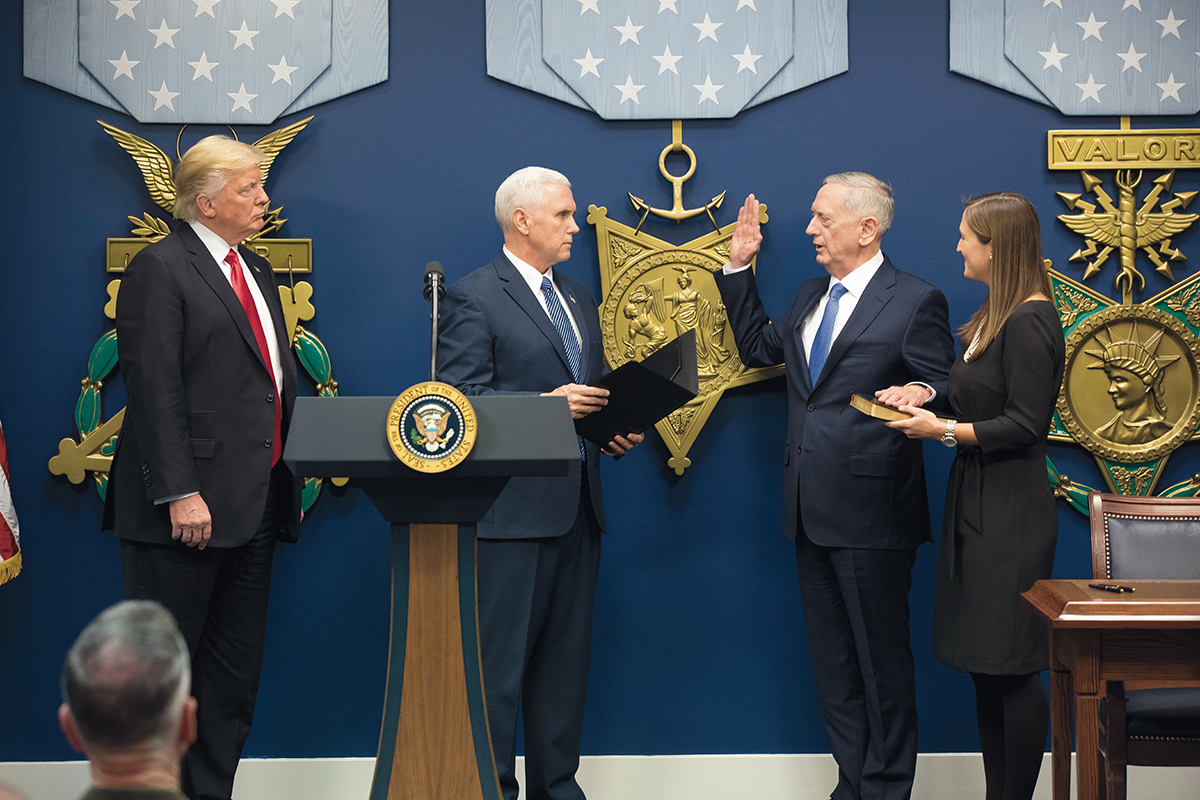What if President Trump Orders Secretary of Defense Mattis to Do Something Deeply Unwise?
Plausible hypotheticals sparked by recent events raise the question whether the Secretary of Defense or someone else high up in the chain of command must obey a presidential order he or she deems deeply unwise. May the Secretary of Defense refuse an order to initiate preemptive war against North Korea because he believes it is a terrible idea that will result in hundreds of thousands of deaths? What steps might the Secretary take to immunize the U.S. Armed Forces from carrying out such presidential commands?

Published by The Lawfare Institute
in Cooperation With

Plausible hypotheticals sparked by recent events raise the question whether the Secretary of Defense or someone else high up in the chain of command must obey a presidential order he or she deems deeply unwise. May the Secretary of Defense refuse an order to initiate preemptive war against North Korea because he believes it is a terrible idea that will result in hundreds of thousands of deaths? What steps might the Secretary take to immunize the U.S. Armed Forces from carrying out such presidential commands? Building on Andrew Kent’s piece from earlier this year on the scope of the President’s authority to control and fire agency heads, and numerous posts about the legality of uniformed service members disobeying orders (see, e.g., here, here, here, and here), we here outline the laws relevant to a Secretary of Defense called upon to effect a reckless order from the President.
The President and the Secretary of Defense together comprise the “National Command Authority,” the civilian team with the power to issue legally-binding orders on members of the military. The President has ultimate authority as Commander-in-Chief and the Secretary of Defense has delegated responsibility to lead the DoD. The Secretary’s authority is explicitly “[s]ubject to the direction of the President,” and like all other appointed cabinet members, the Secretary serves at the pleasure of the President and can be fired at any time for any reason. The Secretary implements the President’s preferred policies by directing the administrative staff, military departments, Joint Chiefs of Staff, the combatant commands, and other DoD entities. These provisions make clear that if the Secretary of Defense refused to obey the President’s order, the President could fire him and every other subordinate who refused to carry out his order until the President finds someone who will.
The Secretary of Defense could not avoid the consequences of the chain of command by issuing orders contrary to the President to his subordinates. The combatant commands are the operational element of the DoD and are responsible for executing the range of combat and peacetime missions in accordance with tasking from the Secretary. 10 U.S.C § 162 specifies their chain of command:
(b) Chain of Command.—Unless otherwise directed by the President, the chain of command to a unified or specified combatant command runs—
(1) from the President to the Secretary of Defense; and
(2) from the Secretary of Defense to the commander of the combatant command.
And 10 U.S.C. § 164 reiterates that they are ultimately accountable to the President, with the Secretary of Defense acting as a proxy:
(b) Responsibilities of Combatant Commanders.—
(1) The commander of a combatant command is responsible to the President and to the Secretary of Defense for the performance of missions assigned to that command by the President or by the Secretary with the approval of the President.
(2) Subject to the direction of the President, the commander of a combatant command—
(A) performs his duties under the authority, direction, and control of the Secretary of Defense
If a disagreement arises between the President and the Secretary of Defense, the President’s view, and whatever orders stem from that view, carry the day. The uniformed leadership then has to either comply or risk being relieved of command and court-martialed in accordance with Article 92 of the Uniform Code of Military Justice. As Colonels Reeves and Wallace explained, these duties of uniformed officers only apply to lawful orders. But the ultimate legality or not of the order might be finally resolved only if there is a court martial under Article 92. And in the meantime, the President could fire a uniformed officer for failing to carry out an order that the officer believed was unlawful. (There is a tricky question as to whether Secretary Mattis, as a retired military officer entitled to pay, is subject to the UCMJ under Article 2(a)(4) and thus bound by its duties and subject to court martial for not obeying a lawful order of the Commander-in-Chief. We do not pursue this matter further because whether he is subject to the UCMJ or not, Trump could fire him for disobeying an order in any event.)
Contrary to these principles, by some accounts, President Nixon’s Secretary of Defense James Schlesinger ordered General George S. Brown, Chairman of the Joint Chiefs of Staff, not to execute Nixon’s orders without checking with him, or (in a different version) ordered military commanders to “check with either him or Secretary of State Henry Kissinger before executing” a nuclear launch order from Nixon. Some historians have thrown cold water on this tale. The esteemed Jeff Smith, by contrast, says that when he was an Army JAG lawyer assigned to the Office of the Deputy Undersecretary of the Army for International Affairs in 1974, he was privy to an order from the Chairman of the Joint Chiefs to the four-star Commanders-in-Chief (as combatant commanders were then known) to the effect that “execute orders” from the National Command Authority should not be carried out “unless the order was verified by the Chairman of the Joint Chiefs and the Secretary of Defense.” However, in a 2007 interview, Schlesinger expressly denied (pp. 39-40) that he told General Brown not to take an unverified order from Nixon. Schlesinger instead says that he told Brown to check with Schlesinger if Brown received an order from “the White House staff,” not Nixon himself. When asked about ordering Brown to disobey an order from Nixon, Schlesinger emphasized that “you can’t do it” because “the president is the commander-in-chief.” He added that his instructions to Brown were designed to preserve, rather than undermine, the “integrity of the chain of command.” We do not know if Schlesinger truthfully recounted the events in question. The important point is that Schlesinger's 2007 explanation correctly states the law that governed in 1974 and governs today.
To say that the Secretary of Defense and his subordinates have a legal duty to comply with presidential orders is not to say that they should do so. It just means that the law of the chain of command requires them to, and they have to be prepared to accept the consequences of defiance. For the Secretary of Defense, that means—if he thinks appropriate—resigning in protest, resisting until fired, informing congressional leaders (in or out of public), or quietly coordinating with the Vice President and others for presidential removal under the 25th Amendment. And whatever the Secretary’s choice, it provides no legal protection to the combatant commanders should they also resist. This might seem like a frustratingly limited set of options. But having an elected President as Commander-in-Chief, and strict adherence to the chain of command, are core elements of civilian control of the military that serve other very important values in the normal course of events. The current conundrum highlights again how very deeply our system of government depends on the People electing a President who is generally reasonable, prudent, and responsible.




.png?sfvrsn=4156d4f8_5)

